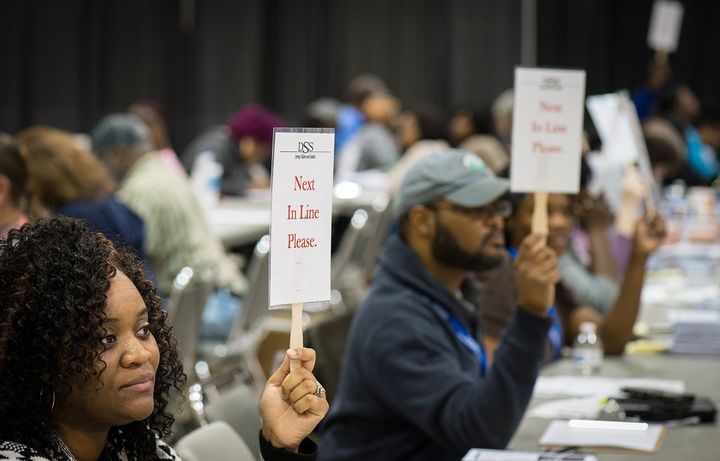
South Carolina Department of Social Services (DSS) staff and volunteers process applications at a temporary processing center such as this Disaster Supplemental Nutrition Assistance Program (D-SNAP) operation that responded to severe flooding in South Carolina.
By Bryce Oates | Daily Yonder
Victims of natural disasters like wildfires and floods may get something they weren’t expecting from government assistance programs: food stamps.
The Supplemental Nutrition Assistance Program (SNAP) is best known for helping low-income families stretch their monthly food budget. But the Department of Agriculture nutrition program is also part of federal emergency responses to wildfires, tornadoes, floods, hurricanes, mega-storms and other natural disasters.
Families in federally declared disaster areas who lose a job, can’t get access to their bank funds, or lose food or housing are eligible to receive the nutrition benefits. In some rural communities, like those in California that faced floods in 2017 and wildfires in 2018, SNAP plays a big role in helping families recover from disasters.
“We are considered second responders to wildfires,” said Daniela Ogden with the California Association of Food Banks’ disaster-relief programs. “Once the immediate disaster is mitigated, we need to take care of people that are impacted. We help people who’ve lost a home, people that are displaced, or people whose place of employment has been disrupted or destroyed.”
Food aid can come in several forms.
“People can come to us to get food at the food bank, and also to sign up for CalFresh (California’s SNAP program) once a disaster has been declared or enacted,” Ogden said. “We try to raise the voice for the variety of assistance available, to elevate the information that these hunger benefits are out there. We try to help people understand their eligibility and to access the programs they need to get back on their feet.”
The California Association of Food Banks, a member association for 41 food banks in California, administers the state’s SNAP program. SNAP is a federally mandated government entitlement program that provides monthly food benefits for low-income households. Each state manages its own plan, and they are administered at the county level.
SNAP nutrition benefits are mandated by the federal farm bill, which is currently going through reauthorization in Congress. The House version of the current legislation would limit SNAP benefits by tightening the work requirements for participants.
People who qualify for SNAP because of a disaster do not have to be working or looking for work to receive the benefits, said Ellen Vollinger with the Food Research and Action Center (FRAC), a national anti-hunger nonprofit. The benefits are normally available for one month but in some cases can be renewed based on the disaster, she said. Benefits after Hurricane Katrina in 2005 ran for three months, for example.
Disaster SNAP recipients automatically receive the maximum amount of aid, which is about $640 a month for a family of four with two young children. That’s enough to feed that family if they are thrifty, according to the USDA. The amount covers about 60 percent of an average family’s grocery budget if they eat according to the USDA “moderate-cost plan.”
“Disaster SNAP benefits are triggered by a presidential declaration of a 'Major Disaster.'”
Disaster CalFresh (known as Disaster SNAP or D-SNAP at the federal level) provides temporary food assistance for households affected by a natural disaster. The program is “available for a number of people, not just those previously enrolled in the regular SNAP program, but for those who have lost food or access to their home because of disasters,” Ogden explained. “Disaster CalFresh is not just for people who live in the impacted area, it’s available to those who might have lost their place of employment. Also, if you’re responsible for a family in need you could also be eligible.”
Disaster SNAP benefits are triggered by a presidential declaration of a “Major Disaster.” Recent declarations that leveraged D-SNAP benefits in rural communities including last summer’s Western wildfires, Hurricane Maria in Puerto Rico, Hurricane Harvey in Texas and Hurricane Irma in Georgia and Florida.
California has had a rough 12 months. Though 2017 started with record precipitation and flooding, the year ended with a record volume of wildfires. Cal Fire reports that more than 9,000 fires burned more than 1.2 million acres in 2017, an increase from 6,986 fires burning around 564,000 acres in 2016. The California Association of Food Banks went to work, coordinating nutrition assistance response activities for fire-impacted communities.
“We try to coordinate response workers with infrastructure, truck drivers who can help move water and food to the people who need assistance and aid in the impacted area,” she said. “Highly trained outreach workers from the more urban food banks in the Bay Area went to areas where impacted families had gathered in concentrated areas to help spread the word about Disaster CalFresh.”
Ogden said that in her experience in responding to the wildfires in rural California, workers in agriculture, construction and tourism are especially likely to be affected by short-term job loss.
“A lot of these people are already kind of hovering on the line of CalFresh eligibility already. With the Sonoma and Napa fires last fall, the agricultural and service workers were hit hardest. Both groups lost employment opportunities, particularly because the region is dependent on tourism and many visitors and guests weren’t sure whether it was safe to travel to the impacted area.”
Ogden said Disaster SNAP can also be part of a region’s economic recovery after a catastrophic event.
“In Sonoma, the Disaster CalFresh program brought in $1.5 million in benefits to help families put food on the table when they needed it most, and to help the community to rebound from disasters.”
Participants purchase food in local markets and stores with the nutrition vouchers. “This is one of the most valuable components of the program,” Ogden said.
